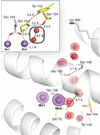Structural basis for activation of class Ib ribonucleotide reductase
- PMID: 20688982
- PMCID: PMC3020666
- DOI: 10.1126/science.1190187
Structural basis for activation of class Ib ribonucleotide reductase
Abstract
The class Ib ribonucleotide reductase of Escherichia coli can initiate reduction of nucleotides to deoxynucleotides with either a Mn(III)2-tyrosyl radical (Y•) or a Fe(III)2-Y• cofactor in the NrdF subunit. Whereas Fe(III)2-Y• can self-assemble from Fe(II)2-NrdF and O2, activation of Mn(II)2-NrdF requires a reduced flavoprotein, NrdI, proposed to form the oxidant for cofactor assembly by reduction of O2. The crystal structures reported here of E. coli Mn(II)2-NrdF and Fe(II)2-NrdF reveal different coordination environments, suggesting distinct initial binding sites for the oxidants during cofactor activation. In the structures of Mn(II)2-NrdF in complex with reduced and oxidized NrdI, a continuous channel connects the NrdI flavin cofactor to the NrdF Mn(II)2 active site. Crystallographic detection of a putative peroxide in this channel supports the proposed mechanism of Mn(III)2-Y• cofactor assembly.
Figures




Comment in
-
Biochemistry. A never-ending story.Science. 2010 Sep 17;329(5998):1475-6. doi: 10.1126/science.1196347. Science. 2010. PMID: 20847256 No abstract available.
Similar articles
-
Class I ribonucleotide reductases: metallocofactor assembly and repair in vitro and in vivo.Annu Rev Biochem. 2011;80:733-67. doi: 10.1146/annurev-biochem-061408-095817. Annu Rev Biochem. 2011. PMID: 21456967 Free PMC article. Review.
-
An active dimanganese(III)-tyrosyl radical cofactor in Escherichia coli class Ib ribonucleotide reductase.Biochemistry. 2010 Feb 16;49(6):1297-309. doi: 10.1021/bi902106n. Biochemistry. 2010. PMID: 20070127 Free PMC article.
-
Streptococcus sanguinis class Ib ribonucleotide reductase: high activity with both iron and manganese cofactors and structural insights.J Biol Chem. 2014 Feb 28;289(9):6259-72. doi: 10.1074/jbc.M113.533554. Epub 2013 Dec 31. J Biol Chem. 2014. PMID: 24381172 Free PMC article.
-
Mechanism of assembly of the dimanganese-tyrosyl radical cofactor of class Ib ribonucleotide reductase: enzymatic generation of superoxide is required for tyrosine oxidation via a Mn(III)Mn(IV) intermediate.J Am Chem Soc. 2013 Mar 13;135(10):4027-39. doi: 10.1021/ja312457t. Epub 2013 Feb 27. J Am Chem Soc. 2013. PMID: 23402532 Free PMC article.
-
Control of metallation and active cofactor assembly in the class Ia and Ib ribonucleotide reductases: diiron or dimanganese?Curr Opin Chem Biol. 2011 Apr;15(2):284-90. doi: 10.1016/j.cbpa.2010.12.001. Epub 2011 Jan 7. Curr Opin Chem Biol. 2011. PMID: 21216656 Free PMC article. Review.
Cited by
-
Reaction landscape of a pentadentate N5-ligated Mn(II) complex with O2˙- and H2O2 includes conversion of a peroxomanganese(III) adduct to a bis(μ-oxo)dimanganese(III,IV) species.Dalton Trans. 2013 Sep 28;42(36):13014-25. doi: 10.1039/c3dt51277k. Epub 2013 Jul 19. Dalton Trans. 2013. PMID: 23872704 Free PMC article.
-
Mechanism of DOPA radical generation and transfer in metal-free class Ie ribonucleotide reductase based on density functional theory.Comput Struct Biotechnol J. 2022 Mar 2;20:1111-1131. doi: 10.1016/j.csbj.2022.02.027. eCollection 2022. Comput Struct Biotechnol J. 2022. PMID: 35317236 Free PMC article.
-
Class I ribonucleotide reductases: metallocofactor assembly and repair in vitro and in vivo.Annu Rev Biochem. 2011;80:733-67. doi: 10.1146/annurev-biochem-061408-095817. Annu Rev Biochem. 2011. PMID: 21456967 Free PMC article. Review.
-
Divergent mechanisms of iron-containing enzymes for hydrocarbon biosynthesis.J Biol Inorg Chem. 2017 Apr;22(2-3):221-235. doi: 10.1007/s00775-016-1425-0. Epub 2016 Dec 21. J Biol Inorg Chem. 2017. PMID: 28004185 Review.
-
Physical interaction between human ribonucleotide reductase large subunit and thioredoxin increases colorectal cancer malignancy.J Biol Chem. 2017 Jun 2;292(22):9136-9149. doi: 10.1074/jbc.M117.783365. Epub 2017 Apr 14. J Biol Chem. 2017. PMID: 28411237 Free PMC article.
References
-
- Nordlund P, Reichard P. Annu. Rev. Biochem. 2006;75:681. - PubMed
-
- Gon S, Faulkner MJ, Beckwith J. Antioxid. Redox Signal. 2006;8:735. - PubMed
-
- McHugh JP, et al. J. Biol. Chem. 2003;278:29478. - PubMed
-
- Monje-Casas F, Jurado J, Prieto-Alamo MJ, Holmgren A, Pueyo C. J. Biol. Chem. 2001;276:18031. - PubMed
-
- Atkin CL, Thelander L, Reichard P, Lang G. J. Biol. Chem. 1973;248:7464. - PubMed
Publication types
MeSH terms
Substances
Associated data
- Actions
- Actions
- Actions
- Actions
- Actions
Grants and funding
LinkOut - more resources
Full Text Sources
Molecular Biology Databases

